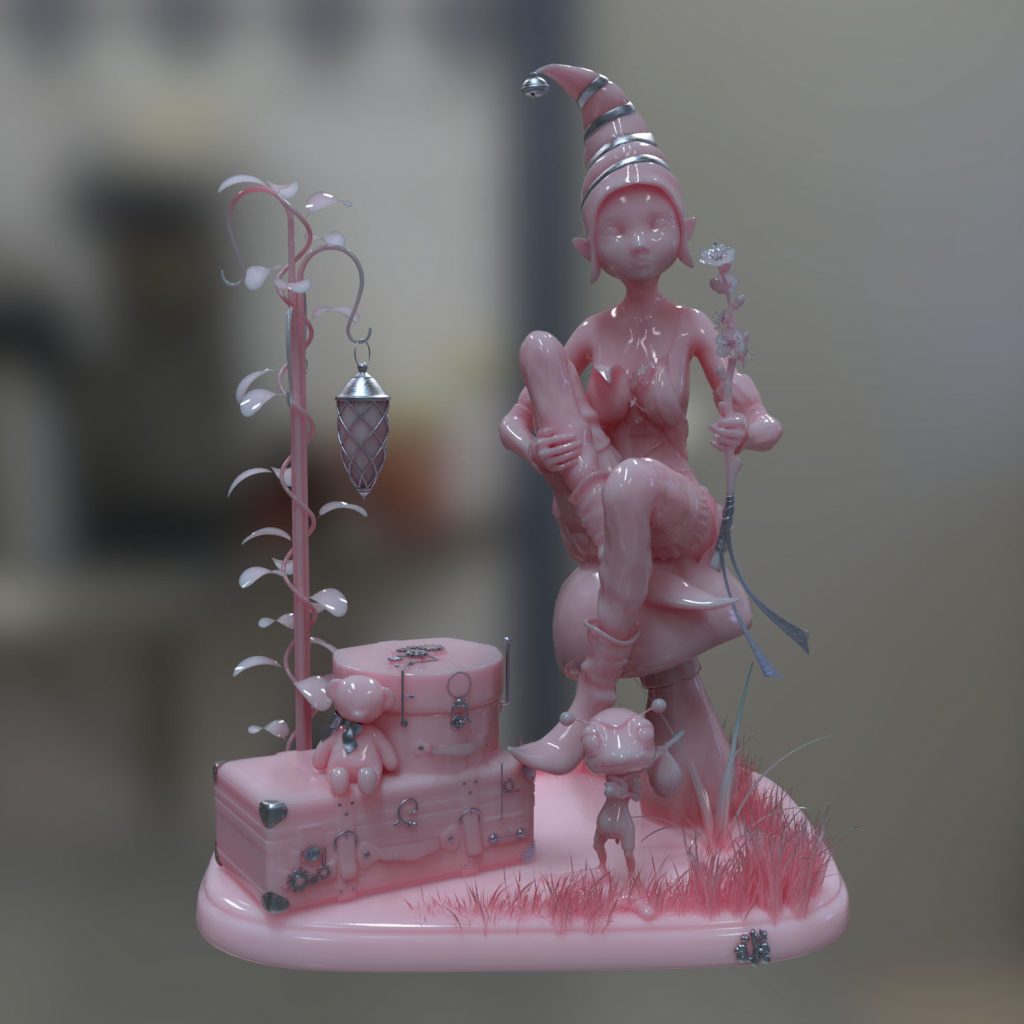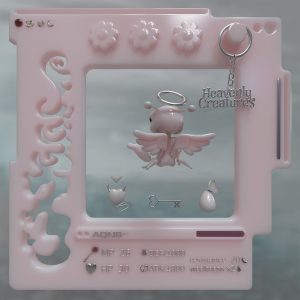“I have an obsession with the idea of tangible, the limitation of touching objects,” writes Alejandra Muñoz, about the boundless potential of working with digital art as a medium. “I wanted to create digital textures that resemble a sculpture.” Based in the city of Nuevo Laredo in Mexico’s Tamaulipas state at the border with the United States, the artist is the fourth to contribute cover art to AQNB’s ongoing art and music compendium series, released today, March 23. It launches with a premiere of Aj simons & umru‘s contribution—’Hate it, love it’—below, and will be our very first physical edition, coming in a limited first run of 50 compact discs, available now for preorder.
Heavenly Creatures takes its title from the 1994 dark biographical drama and queer cult classic film of the same name, with a nod to Los Angeles party Heav3n and its championing of a post-PC Music sound—born online and spread across communication networks the world over. Featuring music by young producers like blackwinterwells, lei, BLOODZ BOI and more, its heavily-filtered, DIY DAW track listing presents a tactility and a hyper-emotionality, which also resonates through Muñoz’s own visual work. That’s reflected in her collaborations with other similarly online-but-intimate artists and collectives, like her poster art for Berlin interdisciplinary platform Creamcake, and cover for Jade Statues‘ delicate MIDI arrangements. Whether it’s in the 3D-renderings of fantastical, porcelain-looking nymphs at play, or the digital illustrations drawing on graphic art aesthetics and kitsch, there’s a distinct melancholy that afflicts all of Muñoz’s mystical beings.

“I think this part of the poem was very violent yet so beautiful,” the artist writes, about the excerpt of a poem called ‘Salvation‘ by Argentine poet Alejandra Pizarnik that briefly graced an early version of the Heavenly Creatures compact disc:
like the sailor in the horror of civilization
that purifies nightfall
Now
the girl discovers the mask of the infinite
and breaks the wall of poetry
“It’s about, not believing in a ‘happily ever after’ reality but in knowing what exists and still just walking, or navigating away from it,” Muñoz explains, extending the cross-sensory potential of her interdisciplinary approach to her practice, from visual art and music into poetry. “I think we have been experiencing this for some time. We realize that’s how things are, and we are still here, so we break the wall of poetry, but we don’t stop there.”
**Tamaulipas sounds like it isn’t so much of a global art centre, and so much of your work is featured in other countries. How do you think this affects you and influences your work?

Alejandra Muñoz: Oh, yes, no actually you are right. I was almost leaving this place but the COVID situation came up and I stayed longer than I wanted to. Right now, I’m planning on leaving to a bigger city, but I think being here has helped me. To be somehow secluded from bigger, artistic communities has hurt me, in a way, because my friends are far away, but also I have learned to be with myself, developing a personal philosophy of how to live my life as an artist.
**Aesthetically, there appears to be a lot of influence from online culture, video game, fantasy, animation etcetera. Do you think this has something to do with the distance and generally decentralised nature of the ‘scene’, or community you participate in? Do you think your work would look different if it wasn’t for this dislocation?
AM: In many ways, yes. Being in quite an isolated place gives me access to process things differently. Internally, I have time to think a lot. There are these moments when you visit a big city and everything is so fast. I love that actually—to see crowds of people walking and talking is amazing and I want that now, but for some time being in this space of the world, being so isolated, has given be time to process pains and things of my life. Being somehow alone also made me utilize every drop of material that I can grab to see and to entertain myself.
**There’s also this tactility to your renderings; there’s a certain ‘imaginary’ to your work, thematically, but also materially it’s a product of the mind that is made to look physically animated. What are your thoughts on this sense of alienation from the physical, making it an exotic subject that is then rendered into a fetishised object that you feel removed from?

AM: You hit right in the nail again :)! Yes, exactly. My artwork represents, in a way, a craving and a wanting for something not existent. With my renders, I try to magnify the representation of a sculpture. It is something you perhaps want to touch, and then is impossible because is digital. It represents the pain of not being able to touch it, and how to process that feeling, because, in my opinion, almost everything is like this. It is a bit cliché, but everything is ephemeral and momentary, even if digitized.
**A colleague of mine lamented that the music of young people today feels depressingly alienated: Gen Z artists raised in front of computer screens who are physically isolated (more so than ever with the pandemic) and interact with each other only remotely—there feels like there is a deep lack and grief in this reality. Is this something you can relate to as an artist and do you think, in some respect, your work tries to remedy this through fantasy?
AM: Oh yes I agree. I believe that we are searching for contact, no matter what happens. I have always believed there is a huge similarity between talking through a chat or video call and being together with a person. It’s definitely not the same, of course, but we search for it. I think my renders and my artwork have a lot to do with this search.
I remember something I saw in an interview from Fiona Apple, which I love very much and I identified with. She said that she would not go out from her house for weeks, because she wanted to feel a thirst and hunger to see people and talk to people. When that happened, then she would go out and do that. I like to come to that point and enjoy it a lot.

**There’s also, however, this deep emotionality to this kind of music, and also your work—an enormous sensitivity and vulnerability toward these aforementioned themes of love and loneliness—do you think the upshot of this perceived alienation is a greater introspection and thus also, perhaps, compassion, or empathy within this culture and context?
AM: This might also sound like a cliché but music has saved me so many times in my life. All the artists in this compilation, and others in the same ambience I think have been giving us literal fuel to keep going. There is an empathy between each other that ends up working a bit like communication, as we are all searching for the same thing.**















